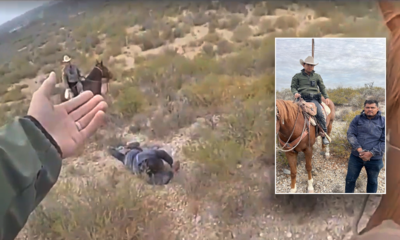Texas
Major update in Texas AMBER Alert after shooting

Two Texas children have been found after police initially thought they were kidnapped following a shooting, according to local reports.
The children, six-year-old Yaretzi Diaz and two-year-old Gael Diaz, have been reported as safe, CBS News Texas reported.
An AMBER alert was issued for their disappearance at 7a.m. on Sunday, according to San Antonio, Texas, news outlet MySA.com, after law enforcement responded to reports of a shooting and believed the children to have been abducted, according to the Wise County Messenger. The children were in fact found at a nearby home.
A suspect in the shooting was identified as 33-year-old Jose Luis Diaz Martinez by Wise County Sheriff Lane Akin, according to the outlet. The Sheriff reportedly said the children were found two hours after the shooting.
Wolfram Steinberg/dpa via AP
A report was first made at around 4:50 a.m., according to CBS. The Sheriff said the call was made by a woman saying her estranged husband had entered the home and shot at a man.
The victim was airlifted to John Peter Smith hospital in Fort Worth, and Sheriff Akin said that his condition was “serious” but was unable to provide further update.
The AMBER alert was canceled when he children were found safe, and authorities no longer believe they were abducted.
A BOLO (be on the lookout) alert was sent out for a white 2007 Nissan pickup Diaz Martinez was believed to be driving, the Wise County Messenger reported.
The vehicle was reportedly stopped at around 8.15 a.m. by Texas Highway Patrol near Clarendon, around 250 miles away from Paradise, where the shooting was reported.
Martinez has reportedly been jailed in Donley County. The Messenger reported that the Wise County Sheriff’s Office and Texas Rangers continue to investigate.
According to the National Center for Missing and Exploited Children, AMBER alerts are activated in the most serious child abduction cases, with the aim of instantly bringing the community together to assist in the search and recovery of the missing child.
An investigation by the center revealed that in 2023, 3,184 cases of missing child reports, either from that year or previous ones, were resolved, and 3,069 cases were reported to center.
The center also provided support for 49 AMBER alert cases initiated by Texas law enforcement in relation to 63 children.
Kidnapping does not often happen in conjunction with violent crime in the U.S. Sccording to Child Watch, less than 2 percent of violent crimes against children included kidnapping.
Do you have a story we should be covering? Do you have any questions about this article? Contact LiveNews@newsweek.com.

Texas
North Texas prepares for major World Cup operations

North Texas FIFA World Cup organizers say this week will bring the first visible signs of activity.
“Tomorrow is a very big day for us,” organizer Monica Paul said. “The move-in for the International Broadcast Center for the World Cup begins. So, they will start moving in a lot of trucks, a lot of building out will take place.”
“I feel like we’re ready for this,” organizer Dan Hunt said. “I mean, this city has been built for this.”
Thousands of media arriving soon
Organizers say that by mid-May, 3,500 broadcasters, media, and staff are expected to arrive at the Kay Bailey Hutchison Convention Center.
Transportation planning will involve coordination across multiple cities and agencies, as millions of fans are expected to move across the region once the tournament begins.
“A large stakeholder group has been taking shape to put this transportation plan together,” Paul said. “Our last mobility plan is due to FIFA at the end of March.”
Security effort spans all levels
Safety and security will involve local, state, and federal partners.
“We are working with the White House Task Force for the World Cup,” Paul said. “It was set up specifically to be our federal government liaison with the host cities to address any concerns.”
Organizers say they want to ensure international visitors feel welcome.
Fan festival to anchor celebrations
For fans without tickets, Fair Park will host the FIFA Fan Festival, a large-scale viewing and entertainment experience during the tournament. The full schedule is expected to be released next month.
“With the good fortune we have here, Dallas Stadium will have nine matches which is over 700,000 tickets,” Hunt said. “Fan fest down in Fair Park should do double that. Almost 1.5 million visitors.”
“What I’m excited about is our Fan Fest is estimated to be free to the public and that excites me because everyone who does not have a ticket can also benefit from the energy of celebrating the World Cup,” organizer Nina Vaca said.
Long‑term goals beyond the tournament
With a projected $2.1 billion economic impact, organizers say the broader goal is to grow the game of soccer in North Texas long after the final match.
Texas
Texas Democrats demand AG investigation into X for alleged child sex content

The X logo on the X app formerly known as Twitter is seen in this photo illustration on 01 November, 2023 in Warsaw, Poland. (Photo by Jaap Arriens/NurPhoto via Getty Images)
AUSTIN – Texas Democrat leaders are demanding that state Attorney General Ken Paxton investigate X, formerly Twitter, and the built-in chatbot Grok for alleged child sex abuse content being generated on the site.
The joint letter from the House leaders says sexualized material is being created at a rate that should trigger a Texas law that would require age verification to use the site.
Texas Democrats request X investigation
What we know:
The Monday letter, signed by 43 House Democrats, references reporting that claims investigators have observed around 7,750 sexualized images being generated per hour and at least one nonconsensual image per minute on X.
They note that Grok has been documented generating sexualized or “nudified” images of minors as well.
According to the House Democrats, other regulators, including those in Europe, have already launched their own queries into the social media site and chatbot. Additionally, they say, the National Center on Sexual Exploitation has called on the DOJ and Federal Trade Commission to investigate X and Grok over the same concerns.
The letter says Texas has already established a standard for sites operating as they claim X does: House Bill 1181, enacted in 2023, requires websites where more than one-third of content is sexual material harmful to minors to use age-verification methods to ensure users are over 18.
Proposed investigation requirements
The letter asks Paxton to look into the following:
- Open a formal investigation into whether X, xAI, Grok, or related tools accessible in Texas are being used to create or distribute unlawful sexually explicit deepfakes, nonconsensual intimate imagery, and any AI-generated child sexual exploitation material, and whether platform design choices are facilitating that conduct.
- Investigate whether X is in compliance with Texas age verification requirements under HB 1181, including whether minors can access sexually explicit material or AI tools that generate sexual imagery without reasonable age verification.
- Issue a public enforcement and reporting pathway for victims and parents in Texas, including instructions to preserve evidence, how reports will be routed for rapid investigation when minors are involved, and a point of contact for legislative coordination.
- Provide written guidance to platforms operating in Texas on compliance expectations, including meaningful age gating for sexually explicit material, prompt removal pathways for victims, and cooperation with law enforcement.
What we don’t know:
Paxton has not yet issued a public response to the letter, or announced an investigation into the matter.
What parents and users should know
If you encounter sexualized images of minors or other abusive material online, report it immediately. In the United States, you can contact the FBI tip line or seek help from the National Center for Missing & Exploited Children.
Do not download, share, screenshot or interact with the content in any way. Even viewing or forwarding illegal material can expose you to serious legal risk.
Parents should also talk with children and teens about AI image tools and social media prompts. Many of these images are created through casual requests that do not feel dangerous at first. Teaching kids to report content, close the app and tell a trusted adult can stop harm from spreading further.
The Source: Information in this article comes from the Texas House Democratic Caucus and previous reporting by Fox News.
Texas
Texas DPS arrests Cowboys defensive end Donovan Ezeiruaku
-

 Montana4 days ago
Montana4 days agoService door of Crans-Montana bar where 40 died in fire was locked from inside, owner says
-

 Technology1 week ago
Technology1 week agoPower bank feature creep is out of control
-

 Delaware5 days ago
Delaware5 days agoMERR responds to dead humpback whale washed up near Bethany Beach
-

 Dallas, TX6 days ago
Dallas, TX6 days agoAnti-ICE protest outside Dallas City Hall follows deadly shooting in Minneapolis
-

 Dallas, TX1 week ago
Dallas, TX1 week agoDefensive coordinator candidates who could improve Cowboys’ brutal secondary in 2026
-

 Virginia4 days ago
Virginia4 days agoVirginia Tech gains commitment from ACC transfer QB
-

 Iowa1 week ago
Iowa1 week agoPat McAfee praises Audi Crooks, plays hype song for Iowa State star
-

 Education1 week ago
Education1 week agoVideo: This Organizer Reclaims Counter Space

























